Aramcon Travel
Aramcon Travel: Nepal — a trek that has it all

Global July 18, 2023 - By
There are over 2,000 trekking companies offering porter and guiding services in Nepal.
“Are … we … there … yet ...?”
No, that wasn’t my 12-year old whining from behind me. That was the sound my middle-aged knees made with each step as we ascended to the Annapurna Base Camp (ABC), and subsequently descended, during a 10-day trekking adventure into the outer edge of Nepal’s Himalaya mountain range.

The Garner family — geologist Nicoli, SAES middle schooler Albert, and I — joined the base camp trek organized by fellow Aramco employee Dan Gaines, an HR policy analyst. Gaines put the trip together as a testing ground for future multiday treks. ABC is a popular trekking challenge, after the Everest Base Camp (EBC) trek, and is promoted as being one out of five on the difficulty scale, with Everest being closer to a five.
My knees would disagree.

Ups and downs
The ABC circuit takes you up, down, and mostly up, as the trails and stone-hewed staircases wend and meander through valleys, along cliffsides, through villages, over dizzying suspension bridges, across terraced farmland, into rhododendron forests, through bamboo, and over slippery snowy paths. We enjoyed sunshine, misty rain, heavy rain, hail, snow flurries, driving snow, and more. This trek has it all.
The difference in difficulty between ABC and EBC, explained our guide, Prem Jirel of Nepal-based trekking company Nepal Peak Adventure, is that the Everest trek reaches a much higher elevation. The higher the altitude, the less oxygen there is for your body to perform at its peak.
There are two ways to make it to any of the base camps: by helicopter or on foot. Going on foot gives you a much deeper, sometimes sobering, and supremely gratifying experience. If you’re pressed for time, or you don’t have the physical ability, and you can afford the additional cost, the helicopter ride is for you. But if you take that helicopter, you won’t experience the daily lives immersed in the trekking trails.

You won’t walk through rich farmlands growing corn, beans, cabbage, and potatoes in the terraced fields above and below you.
It won’t dawn on you during dinner that those same vegetables you see growing are prepared in the meals you’re eating along the way.
You won’t take a moment to stop and watch a local basket-maker transforming bamboo shoots into the large baskets used to transport — by foot, carried on the backs of a huge network of porters — goods such as noodles, propane tanks, and toilet paper up into the isolation of the higher altitudes.

You won’t stumble across a colony of Nepal gray langur monkeys foraging on the forest floor.
You will miss happening upon stream-powered mills grinding maize into flour or powering small village hydro systems. These small moments bring huge gratification.
It is while walking endlessly for upwards of seven hours a day that you realize there are no roads. No motorized vehicles bringing the essentials to the higher elevations.
Helicopters are expensive, human labor is not. So, all goods are carried uphill on the backs of foot-powered transporters. Coming from a land dominated by motorization, this realization is extremely humbling.

Groaning knees
The physical toll is significant. Climbing endless hillocks and stone staircases, coupled with the depleted oxygen as the trek ascends higher, showed me exactly where my fitness was lacking.
Weekly weightlifting and sprint cardio sessions were not enough. The trek began at around 1,500 meters above sea level, culminating at ABC’s 4,130 meters.
For comparison, Dhahran sits 56 meters above sea level. My lungs burned from a lack of cardio preparedness; my knees groaned from inflexibility.

There were sobering moments along the trail. Witnessing the limp body of a tourist suffering from altitude sickness, for example, carried from ABC down to the Machhapuchhare Base Camp (MBC) was a grave reminder of what adventure means.
This gave me pause, and after a sleepless night, I made the decision to remain at MBC while others ascended to ABC at first light.
The peak trekking months in Nepal are October through November, and March through April. Judging by the trail traffic, our April trip was deep into prime tourist season.

Who travels these trails? Pretty much everyone. And according to guide Jirel, there are over 2,000 trekking companies offering porter and guiding services in Nepal. We encountered solo trekkers, couples, families, 20-year old besties who’d just met while backpacking in Thailand, and groups averaging 20 people. Everyone comes from everywhere, united by a sense of adventure, the physical challenge, and a friendly “Namaste” along the way.
Caption for top photo: Dan Gaines and Jessica Weirmier pause after traversing the Tikhedhunga Khola River. It was a harrowing experience crossing one of many suspension bridges. (Photo by Nicoli Garner)



